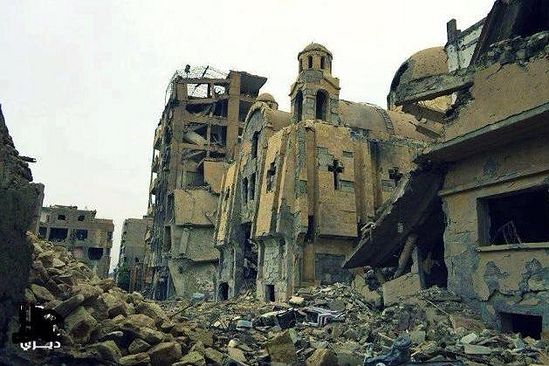Destruction of Historic Monasteries in Syria: The War on the Past

Wissam Abdallah – November 2015 – Notes on Arab Orthodoxy
Christian antiquities are spread throughout the geography of Syria. Some are an extension of ancient civilizations, while others were built by early Christians. The war in Syria poses a danger for these antiquities, such as monasteries, icons and manuscripts which are being destroyed or looted by antiquities dealers.
Christian antiquities are considered part of the landscape of cultural heritage in Syria, where most of them fit the ten criteria for inclusion on UNESCO’s world heritage list.
In Northern Syria, between the hinterlands of Idlib and Aleppo, stretches what is known as the limestone massif, which contains a collection of historic sites such as the church of Qalb Lozeh, Serjilla, and the Church of Saint Simeon Stylites. This region is considered to be the original home of the “stylite monks” when asceticism spread around the world and the history of the monuments there goes back more than 1400 years. Information from the area indicates that the Church of Saint Simeon Stylites has been damaged when it was turned into a training-ground by a group called Liwa’ al-Tawhid [“The Monotheism Brigade”] and the interior of the monastery and church was damaged. This is in addition to digging and exploration work in the monastery, which also caused damage.
The Directorate for Antiquities and Museums in Syria states that in the region of Jisr al-Shughur, a rebel group has attacked two churches and a monastery in the village of Jdaydeh and the theft of 11 icons registered with the Department of Antiquities in Idlib. The church of Qalb Lozeh, one of the most important Byzantine sites in Northern Syria, has been damaged as a result of excavations and vandalism to the church’s stone facade.
In Aleppo, where both man and stone suffers from the war, the Armenian Catholic Archdiocese has suffered the partial destruction of a 200 year-old church, and the Syriac Orthodox Cathedral, the Cathedral of Our Lady of Perpetual Help, and the Armenian Orthodox Cathedral have been targeted by rockets.
The Syrian Desert was the final destination for Armenians fleeing the Ottoman massacres in the early 20th century. They took shelter in Deir ez-Zor and built the Church of the Armenian Martyrs there, which housed relics and documents from the time of the massacres. After it entered the city, ISIS published pictures of the destruction of the church in the Rashidiya neighborhood, known as the Church of the “Martyrs of the Land”, and extremist groups raised their flag over the rubble of the church. Liwa Ansar al-Sunna [“The Advocates of the Sunnis Brigade”] published a video showing members of the group in possession of manuscripts belonging to one of the churches of Deir ez-Zor, where they discussed with an antiquities dealer the price for their sale.
Churches in Homs have been damaged in various combat zones and the churches in the Old City of Homs in particular were burned and destroyed as a result of their lying along the line of fire between rebel groups and the Syrian Army. The Umm al-Zunnar Church, the Church of the Forty Martyrs, the Greek Catholic church, the Protestant church and others were looted and damaged. After the conclusion of the ceasefire and the withdrawal of the rebels, work began to rebuild the buildings that were destroyed as well as the gradual return of the area’s residents to life there, with prayers and religious services, even before rebuilding was completed.
The latest thing ISIS has done is to destroy the historic Monastery of Saint Elian in the town of al-Qaryatayn to the south of Homs, where they used bulldozers to destroy the walls of the monastery, which dates to the 5th century. They also kidnapped a number of the town’s residents and published pictures of “the establishment of God’s rule over the Christians of the city of al-Qaryatayn”, imposing the restrictions fordhimmis on them.
In the province of Hassake, villages along the Khabour river have been subjected to attacks from ISIS. These villages are populated for the most part by Assyrians and Chaldeans who are the continuation of Mesopotamian civilization. Historic churches in the region have been destroyed and more than 100 people have been kidnapped.
Monasteries are sheltered along the slopes of the Qalamoun Mountains, but as a result of their proximity to the Lebanese border, the fires of the Battle of Qalamoun have reached them. Located in the region of Nabak, the Syriac Orthodox Monastery of Mar Mousa the Ethiopian sits on a mountain peak 1320 meters above sea level. It has been attacked by rebels who stormed it in search of money and weapons, stealing as much food as possible from the monastery’s farm. Close by lies the Monastery of Saint James the Persian in the region of Qara, which has also had its possessions and icons pillaged. In Maaloula, churches were burned and historic icons were stolen. The Monastery of Saint Thekla was burned and the Tomb of Saint Thekla was destroyed. The Church of Saints Sergius and Bacchus, one of the oldest churches in the world, was shelled and its contents were looted. With the return of the village’s inhabitants, reconstruction work has begun and efforts have been made to recover what was stolen, some of which had reached the area of Arsal in Lebanon.

612359 286967Not long noticed concerning your internet site and are still already reading along. I assumed ill leave my initial comment. i do not verify what saying except that Ive enjoyed reading. Good blog. ill be bookmarking maintain visiting this internet website really typically. 614293
899032 740197You made some excellent points there. I did a search on the topic and located most people will agree with your blog. 65077